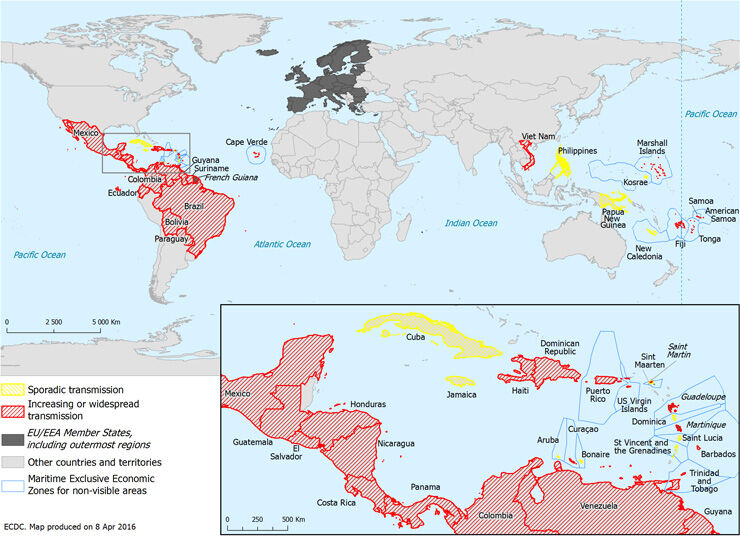Epidemiological update: Outbreaks of Zika virus and complications potentially linked to the Zika virus infection, 7 April 2016
Since last week: Saint Lucia:On 7 April, the Ministry of Healthconfirmed the first two autochthonous cases of Zika virus infection.
New developments since the last epidemiological update published on 1 April 2016
Since last week:
- Saint Lucia:On 7 April, the Ministry of Healthconfirmed the first two autochthonous cases of Zika virus infection.
- Vietnam:On 5 April, the Ministry of Healthreported two confirmed autochthonous cases of Zika virus infection, one case in Khánh Hòa Province with disease onset on 26 March and one case in Ho Chi Minh City with disease onset on 29 March.
- Fiji:The Pacific Public Health Surveillance Network has reported 15 Zika virus cases since the end of 2015.
- Colombia:Between week 40 2015 and as of 26 March 2016, there have been 2 603 confirmed and 58 790 clinically suspected Zika virus cases in Colombia. Since week 5, the number of reported Zika virus cases in the country has been declining, according to the Ministry of Health.
Publication
On 5 April, the Lancetpublished an article about a case of a 32-year-old man whose Zika virus infection was identified in January in the Toulouse University Hospital (France). He presented with clinical symptoms typical of an arbovirus infection two days after returning to France from Brazil and French Guyana. He completely recovered in a few days and further blood, urine, and semen samples were collected 2 weeks after diagnosis. The viral load in the semen was roughly 100 000 times that of his blood or urine more than 2 weeks after symptom onset. The explanation for this difference is unknown and needs further investigation.
Detailed epidemiological situation
As of 7 April 2016, autochthonous cases of Zika virus infection have been reported from 45 countries and territories worldwide in the past two months (see Table 1 and Figure 1). 48 countries and territories have reported autochthonous cases of Zika virus infection in the past nine months (see Table 1 and Figure 2).
Several countries in the Americas, Caribbean and the Pacific continue to report an increase in autochthonous cases of Zika virus infection.
Table 1. Countries and territories with reported confirmed autochthonous cases of Zika virus infection in the past two months, as of 8 April 2016
| Country/Territory | Affected in the past 2 months | Affected in the past 9 months |
|---|---|---|
| American Samoa | Increasing or widespread transmission | Yes |
| Aruba | Sporadic transmission | Yes |
| Barbados | Increasing or widespread transmission | Yes |
| Bolivia | Increasing or widespread transmission | Yes |
| Brazil | Increasing or widespread transmission | Yes |
| Bonaire | Sporadic transmission | Yes |
| Cape Verde | Increasing or widespread transmission | Yes |
| Colombia | Increasing or widespread transmission | Yes |
| Cuba | Sporadic transmission | Yes |
| Costa Rica | Increasing or widespread transmission | Yes |
| Curaçao | Increasing or widespread transmission | Yes |
| Dominica | Sporadic transmission | Yes |
| Dominican Republic | Increasing or widespread transmission | Yes |
| Ecuador | Increasing or widespread transmission | Yes |
| El Salvador | Increasing or widespread transmission | Yes |
| Fiji | Increasing or widespread transmission | Yes |
| French Guiana | Increasing or widespread transmission | Yes |
| Guadeloupe | Increasing or widespread transmission | Yes |
| Guatemala | Increasing or widespread transmission | Yes |
| Guyana | Increasing or widespread transmission | Yes |
| Haiti | Increasing or widespread transmission | Yes |
| Honduras | Increasing or widespread transmission | Yes |
| Jamaica | Sporadic transmission | Yes |
| Kosrae | Sporadic transmission | Yes |
| Marshall Islands | Increasing or widespread transmission | Yes |
| Martinique | Increasing or widespread transmission | Yes |
| Mexico | Increasing or widespread transmission | Yes |
| New Caledonia | Sporadic transmission | Yes |
| Nicaragua | Increasing or widespread transmission | Yes |
| Panama | Increasing or widespread transmission | Yes |
| Papua New Guinea | Sporadic transmission | Yes |
| Paraguay | Increasing or widespread transmission | Yes |
| Philippines | Sporadic transmission | Yes |
| Puerto Rico | Increasing or widespread transmission | Yes |
| Saint Martin | Increasing or widespread transmission | Yes |
| Saint Vincent and the Grenadines | Sporadic transmission | Yes |
| Samoa | Increasing or widespread transmission | Yes |
| Saint Lucia | Sporadic transmission | Yes |
| Sint Maarten | Sporadic transmission | Yes |
| Solomon Islands | No | Yes |
| Suriname | Increasing or widespread transmission | Yes |
| Thailand | No | Yes |
| Tonga | Increasing or widespread transmission | Yes |
| Trinidad and Tobago | Increasing or widespread transmission | Yes |
| Vanuatu | No | Yes |
| Venezuela | Increasing or widespread transmission | Yes |
| Viet Nam | Increasing or widespread transmission | Yes |
| US Virgin Islands | Increasing or widespread transmission | Yes |
The classification of countries above is based on: 1) number of reported autochthonous confirmed cases; 2) number of affected areas in the country; 3) duration of the circulation.
EU/EEA and EU Outermost Regions and Territories
As of 7 April, no autochthonous vector-borne Zika virus transmission has been reported in the continental EU. ECDC is collecting data regarding imported cases through the media and official government communication lines. As of 7 April 2016, ECDC has recorded 359 cases imported in 17 EU/EEA countries. Twenty-three cases are among pregnant women. In addition, one confirmed case has been published following diagnosis in a Slovenian hospital. The number of imported cases reported is not based on a systematic reporting surveillance systems hence cannot be considered exhaustive.
Several of the EU’s Outermost Regions and Territories continue to report autochthonous transmission.
- Martinique: As of 7 April 2016, 16 650 suspected cases have been reported, an increase of 1 260 during the past week.
- French Guiana: As of 7 April 2016, 3 620 suspected and 355 laboratory-confirmed cases have been reported, an increase of 430 suspected and 37 laboratory-confirmed cases during the past week.
- Guadeloupe: As of 7 April 2016, 1 090 suspected and 191 laboratory-confirmed cases have been reported, an increase of 180 suspected and 52 laboratory-confirmed cases during the past week.
- Saint Martin: As of 7 April 2016, 160 suspected and 42 laboratory-confirmed cases have been reported, this is an increase of three suspected and six laboratory-confirmed cases during the past week.
Figure 1. Countries or territories with reported confirmed autochthonous cases of Zika virus infection in the past two months, as of 8 April 2016

Figure 2. Countries and territories with reported confirmed autochthonous cases of Zika virus infection in the past nine months, as of 8 April 2016

Update on the observed increase of congenital Zika syndrome and other neurological complications
In the context of Zika virus circulation, 13 countries or territories have reported an increased incidence of Guillain-Barré syndrome (GBS) and/or laboratory confirmation of a Zika virus infection among GBS cases, according to WHO.
So far only French Polynesia, Brazil and Colombia have reported an increase in Zika congenital syndrome.
Brazil
Between 22 October 2015 and 2 April 2016, 6 906 cases of microcephaly and/or central nervous system (CNS) malformations were reported by Brazil. This contrasts with the period from 2001 to 2014, when an average of 163 microcephaly cases was recorded nationally per year. Of the 6 906 cases of microcephaly and/or CNS malformations reported in Brazil, investigations have been concluded for 2 860 cases and 1 046 were suggestive of congenital infection. Microcephaly and/or CNS malformation cases have been detected in 21 out of 27 states in Brazil, but the reported increase is concentrated in the northeast region, according to WHO.
Among the 6 906 cases of microcephaly and/or CNS malformation reported in Brazil, 227 child deaths occurred after birth or during pregnancy (including miscarriage or stillbirth); 51 of these had microcephaly and/or CNS malformation suggestive of congenital infection, 148 remain under investigation and 28 were discarded.
Colombia
On 30 March, Colombia reported 50 live births with microcephaly between 4 January and 20 March 2016. This number represents an increase compared to the historical annual average expected (140 cases per year). Of the 50 cases registered, 18 were discarded.
So far, seven of the remaining 32 cases presented Zika virus positive results by real-time PCR, according to WHO.




